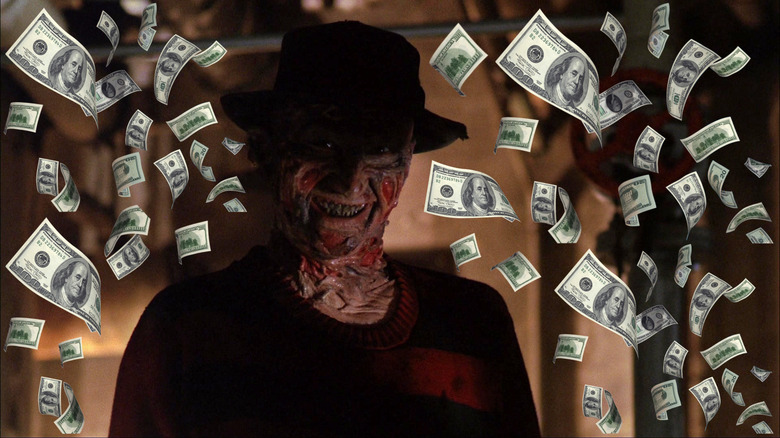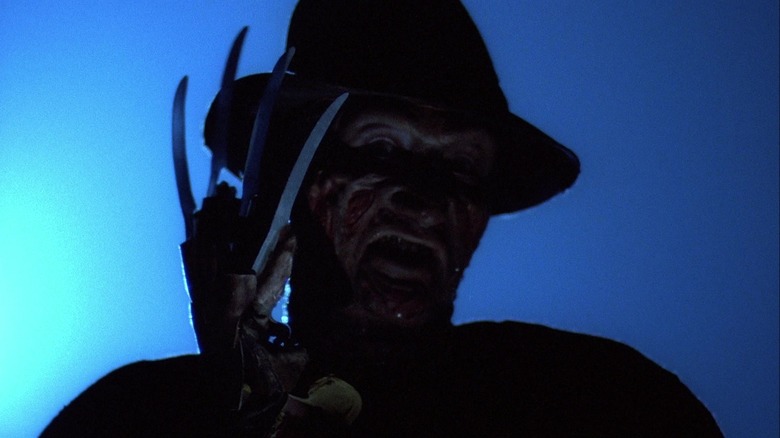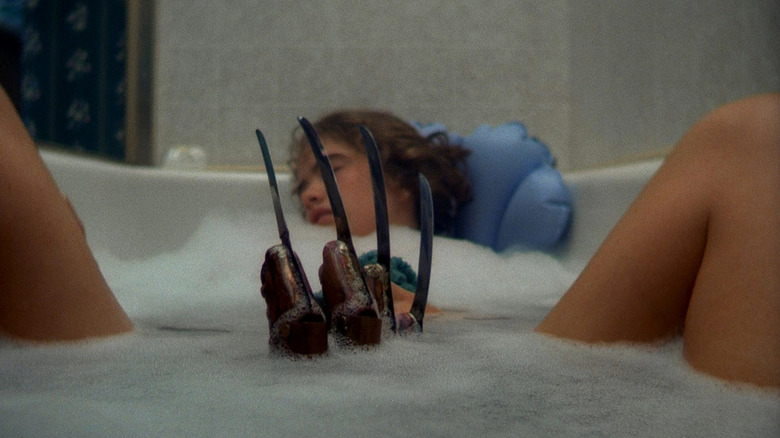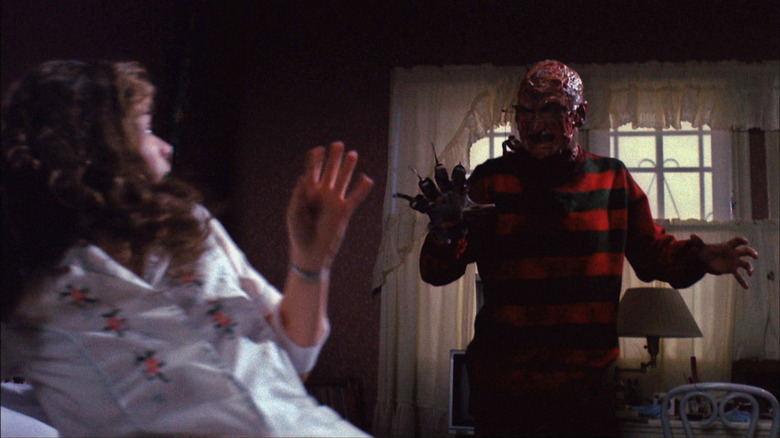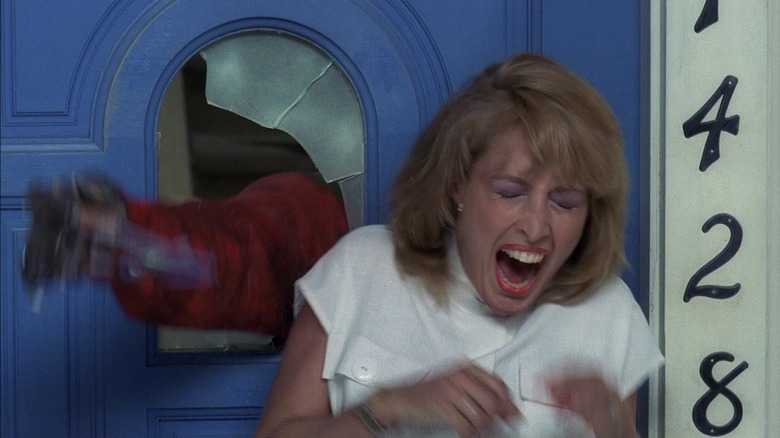40 Years Ago, Wes Craven's Greatest Horror Creation Became A Box Office Sensation
(Welcome to Tales from the Box Office, our column that examines box office miracles, disasters, and everything in between, as well as what we can learn from them.)
"Every studio rejected it." These are the words of the late horror master Wes Craven, speaking in a 2014 oral history with Vulture regarding his 1984 cinematic classic "A Nightmare on Elm Street." It's difficult to imagine the horror genre — if not broader pop culture — without Freddy Krueger in it, but it was, indeed, a Herculean task getting this now-classic horror movie made. "I have the rejection letter from Universal framed on my office wall," Craven added.
What's perhaps most amazing of all is that this wasn't even Craven's first film. The man that would eventually go on to save the slasher in the '90s with "Scream" already had "Last House on the Left" and "The Hills Have Eyes" on his resume, as well as some made-for-TV flicks. Yet, the notion of a killer who murders teenagers in their dreams was, at the time, too much for Hollywood to handle. That is, until the script wound up on the desk of one Mr. Robert "Bob" Shaye at New Line Cinema. It proved to be a match made in heaven, and a match that made the studio an awful lot of money.
In this week's Tales from the Box Office, we're looking back at the original "A Nightmare on Elm Street" in honor of its 40th anniversary. We'll go over the film's real-life-inspired origins, what was going on with the horror genre at that time, why New Line was willing to bet on Craven's idea, what happened when the movie hit theaters, what happened after it became a success, and what lessons we can learn from it four decades later. Let's dig in, shall we?
The movie: A Nightmare on Elm Street (1984)
"A Nightmare on Elm Street" as we know it centers on several Midwestern teenagers who fall prey to Freddy Krueger (Robert Englund), a heavily-burnt serial killer who hunts and slays the teenagers in their dreams. Unfortunately for them, when they die in their dreams, they also die in real-life. With time, however, one of the teenagers — Heather Langenkamp's Nancy — begins to suspect that a dark secret kept by her and her friends' parents may be the key to unraveling this mystery. As such, it falls to her and her boyfriend Glen (Johnny Depp) to get to the bottom of things before it's too late.
"I couldn't get any work. No paycheck for three years," Craven explained in that same Vulture oral history. The failures of his films "Deadly Blessing" and "Swamp Thing" made it tough for Craven to get a gig at the time. "I lost my house. I had to borrow money from ['Friday the 13th' director] Sean [Cunningham] to pay my taxes. Also, my first marriage had failed, and I was smoking a lot of grass, then graduated to cocaine. Finally, I walked away from the drugs. And I had this one idea, so I set off to write a script."
That idea would turn into the script for "A Nightmare on Elm Street," which was actually inspired by a pretty haunting true story. It was one that resonated with Craven enough that it generated the central idea that would serve as the basis of the film:
"I'd read an article in the L.A.Times about a family who had escaped the Killing Fields in Cambodia and managed to get to the U.S. Things were fine, and then suddenly the young son was having very disturbing nightmares. He told his parents he was afraid that if he slept, the thing chasing him would get him, so he tried to stay awake for days at a time. When he finally fell asleep, his parents thought this crisis was over. Then they heard screams in the middle of the night. By the time they got to him, he was dead. He died in the middle of a nightmare."
Once Craven had the script, it was about finding someone to put up the money for the film. Enter Bob Shaye, the then-head of New Line Cinema, a small player in Hollywood at the time.
Creating Freddy Krueger, the killer of our nightmares
Craven was connected to Shaye via Jack Sholder, who would eventually direct "A Nightmare on Elm Street 2: Freddy's Revenge." Shaye resonated with the material and, ultimately, became the man to take a chance on Craven's wild idea. As Shaye explained in the Vulture piece:
"I went to L.A. for a fact-finding trip and contacted Wes. He told me the story — I thought it was a fantastic, because everybody has nightmares. I got pretty excited, but he wouldn't send me the script. Little did I know, everybody else in Hollywood had already passed."
Indeed, every studio in town passed on "Elm Street." Disney showed some interest, but it wanted to make the film PG-13, among other changes. Luckily, Shaye signed on and it was off to the races. Langenkamp, then a newcomer, was brought on to play Nancy, while Depp (another newcomer at the time) signed on to play her boyfriend, Glen. Despite having a monster career in the decades that followed, "Nightmare" remains one of Depp's most critically-beloved movies, interestingly enough.
As for Freddy Krueger, the killer of "Elm Street" was inspired by someone from Craven's own life as a child. When interviewed for the documentary "Never Sleep Again," the filmmaker described the encounter he'd had with a strange man in his youth and how it ultimately birthed an icon of the horror genre:
"I think [he] was a drunk, walking down the street. He just somehow knew I was there, and he stopped and he looked [wide-eyed] right at me and just held that. It scared the s**t out of me."
That stuck with Craven and, even down to the man's fedora, it inspired who we now know as Freddy. Working man's actor Robert Englund ("V") was cast to take on the role of Freddy, even though he had only briefly dabbled in horror thanks to a role in Tobe Hooper's "Eaten Alive." In a 2023 interview with /Film, Englund explained:
"I was a huge horror fan as a child. It's not that I outgrew it, I just became other things. I became a classically trained theater actor and I was a little bit full of myself for a while and I kind of pushed that in the back of my mind, but I think with me, I think it's kind of just the luck of aging. Freddy was only my second horror film."
Englund proved to be the secret sauce, as his portrayal of Freddy was front-and-center in the marketing. Along with Craven's original story and deft skill behind the camera, it all gelled together, allowing New Line's risky investment to pay off handsomely.
The financial journey
It's worth pointing out that by 1984, slashers were the dominant force in horror. Beginning with John Carpenter's "Halloween" in 1978 and super-charged by the success of "Friday the 13th" in 1980, particularly as Jason Voorhees took center stage in the many sequels, these were the bread and butter of mainstream horror at the time. So, on the one hand, Craven's film made sense. On the other hand, could New Line effectively sell a slasher who comes for kids in their dreams? It was a challenge, yes, but one that the studio rose to. It turns out, audiences were ready for something fresh.
Ultimately, New Line put up a $1.8 million budget for the film, which was more than Craven had planned on. Still, it was low-budget by Hollywood standards, even if we account for inflation. The studio also decided to avoid the more crowded Halloween frame in mid-to-late October, instead opting for a more quiet, early November release. That was another decision that paid off for all involved.
"A Nightmare on Elm Street" opened on November 9, 1984, playing on just 165 screens on its opening weekend. While "Oh, God! You Devil" easily topped the charts, playing on nearly 1,400 screens, "Elm Street" still cracked the top 10. What's more, Craven's film had by far the best per-screen average in the top 10 that weekend, taking in $1.27 million, making for $7,703 per screen. As a result, the film added screens in the following weekend as word of mouth spread. While it never climbed very high on the charts, in no small part thanks to bigger hits such as James Cameron's "The Terminator," the movie hung around through early 1985, quietly making its money.
All told, "Elm Street" made $25.5 million domestically during its original run. Overseas grosses both weren't as much of a thing at that time for many films, and they also weren't as widely reported. But rest assured, New Line made money with this movie in overseas markets, as well as on home video in the months/years that followed (not to mention via merchandise). It was a home run.
Wes Craven gives birth to a new horror franchise
Purely at the box office and not counting the film's eventual home media sales and rentals, Craven's film made back more than 15 times its production budget. As such, "A Nightmare on Elm Street 2" quickly followed in 1985, with five more sequels arriving across the ensuing decade, all of them featuring Englund as Freddy. By 1991, the combined "Elm Street" films had brought in some $500 million in worldwide revenue. To date, the franchise has netted more than $450 million at the global box office.
Put simply, "A Nightmare on Elm Street" saved New Line Cinema and put it on the map, so much so that it is commonly known as "the house that Freddy built." What remains unique, even to this day, is Freddy. While the man under the mask only matters so much when we're talking about Michael Myers or Jason Voorhees (all due respect), Englund's portrayal as Freddy was absolutely crucial. He brought a signature to that role. That's probably why we haven't had a reboot for the modern era, as replacing Englund is no small task.
As is always the case, the well eventually runs dry. Craven returned to helm 1994's "New Nightmare," which was largely ignored at the box office despite now being heralded as one of the best films in the franchise. But that was the end of the classic era of this series. Englund would return for 2003's "Freddy vs. Jason" and that was that. Likewise, the larger franchise was revived with the ill-advised 2010 remake starring Jackie Earle Haley as Freddy, which made more than $117 million worldwide but was panned widely by critics and never received a sequel.
Still, Craven birthed a franchise that is shockingly enduring and hugely profitable. The "Elm Street" films are still hugely popular and Freddy Krueger is a horror icon with few rivals of his size. In the years that followed, Craven asserted himself as a true master of the genre, with this marking the true turning point in his illustrious career. No more going without a paycheck for years on end, to be certain.
The lessons contained within
For what it's worth, Craven has his regrets about "A Nightmare on Elm Street," particularly the film's ending. Shaye wanted to leave the door open for a sequel and Craven relented, which proved to be good business. That said, Craven treated the material very seriously, as did Shaye. It wasn't a pure, artless cash grab like so many other one-and-done slashers at the time. There was a land grab to get all of that Jason Voorhees money at the time. Freddy undoubtedly benefited from that, but Craven's originality was what truly allowed the film to thrive.
It is difficult to process but we're still forced to live in a world where horror is viewed, by default, as a lesser genre. It's only the rarest of rare exceptions that get to exist as art, such as Jordan Peele's "Get Out." But to my eye, Craven's "Elm Street" is as inventive and serious as anything else. Did the sequels eventually get more ridiculous? Of course. But none of that happens without the original, which is a legitimate piece of cinema. Craven and everyone else involved in making the film treated it with a good deal of respect. It shows, even 40 years later.
Langenkamp and Englund, for their part, believe that is the key to the film's ongoing success as well. In a recent interview with /Film to celebrate the 4K release of "A Nightmare on Elm Street," Langenkamp praised Englud's approach to Freddy, which she believes was the primary ingredient:
"The seriousness that he approached the character really transcends, I think, every other horror movie monster ever, and I think it's sheerly from his own effort and from the amount of love — weird word to use — but the love that he had for the acting project that was creating Freddy Krueger."
Indeed, that love and respect for the material worked like gangbusters. Shaye understood that. Craven understood that, and audiences in 1984 felt that. Horror isn't lesser than. Craven was a master filmmaker. "A Nightmare on Elm Street" is a cinematic classic that literally made the name of a major Hollywood studio. It just happens to be a horror movie.
